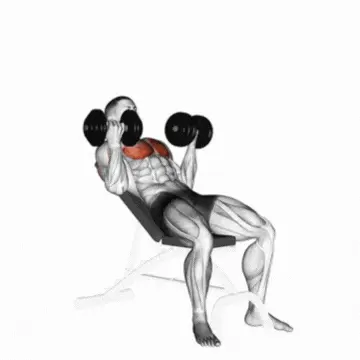Reverse Grip Incline Dumbbell press- Form, Faults & Benefits l Reverse Grip Bench Press
In this article, we’ll discuss the Reverse Grip Incline Dumbbell Press, including proper form, common faults to avoid, and the many benefits of this exercise. We’ll also compare the reverse grip bench press to other chest exercises and discuss how to incorporate it into your workout routine.

Form of Reverse Grip Incline Dumbbell Press
The reverse grip incline dumbbell press is a challenging exercise that targets the upper chest, triceps, and shoulders. Here’s how to perform the exercise with proper form:
Step 1: Set up your bench at a 30 to 45-degree angle and grab a pair of dumbbells.
Step 2: Sit on the bench and lie back, keeping your feet flat on the floor and your back and head against the bench.
Step 3: Hold the dumbbells with a reverse grip, which means your palms are facing toward you and your knuckles are facing away.
Step 4: Position the dumbbells above your chest, with your elbows bent at a 90-degree angle and your upper arms parallel to the ground.
Step 5: Exhale and press the dumbbells upward, extending your arms until they are straight but not locked.
Step 6: Inhale and slowly lower the dumbbells back down to the starting position.
Step 7: Repeat the movement for the desired number of reps.
To get the most out of this exercise, it’s important to maintain proper form. Here are some tips to keep in mind:
Tip 1: Keep your core engaged throughout the exercise to maintain stability and prevent your lower back from arching.
Tip 2: Focus on using your chest muscles to lift the dumbbells, rather than relying on your shoulders or triceps.
Tip 3: Avoid locking your elbows at the top of the movement, as this can put unnecessary strain on your joints.
Tip 4: Use a weight that allows you to perform the exercise with proper form and without excessive strain.
Faults of Reverse Grip Incline Dumbbell Press
While the reverse grip incline dumbbell press is an effective exercise for building upper chest strength, there are some common faults to watch out for. Here are a few of the most common faults and how to avoid them:
Fault 1: Arching the back
When performing the reverse grip incline dumbbell press, it’s important to keep your back and head against the bench. Arching your back can put unnecessary strain on your lower back and reduce the effectiveness of the exercise. To avoid this fault, engage your core throughout the movement and focus on keeping your back flat against the bench.
Fault 2: Flaring the elbows
Another common fault of the reverse grip incline dumbbell press is flaring the elbows outward. This can put excessive strain on your shoulders and reduce the effectiveness of the exercise. To avoid this fault, keep your elbows close to your sides and focused on lifting the dumbbells with your chest muscles.
Fault 3: Using too much weight
Using too much weight can cause you to lose proper form and increase the risk of injury. To avoid this fault, start with a lighter weight and focus on proper form and technique. Gradually increase the weight as your strength and form improve.
Benefits of Reverse Grip Incline Dumbbell Press
The reverse grip incline dumbbell press offers a range of benefits for those looking to build upper chest strength and improve overall fitness. Here are some of the key benefits of this exercise:
Benefit 1: Targets the upper chest
The incline angle of the bench and the reverse grip of the dumbbells target the upper chest muscles, which can be difficult to engage with other exercises. By focusing on the upper chest, you can develop a more well-rounded and defined chest.
Benefit 2: Works multiple muscle groups
In addition to targeting the upper chest, the reverse grip incline dumbbellpress also works the triceps and shoulders, making it a great compound exercise that targets multiple muscle groups.
Benefit 3: Increases strength and muscle mass
As with any strength training exercise, the reverse grip incline dumbbell press can help increase both strength and muscle mass in the targeted muscle groups. This can lead to improved overall fitness and a more sculpted physique.
Benefit 4: Can improve posture
By strengthening the upper chest muscles, the reverse grip incline dumbbell press can help improve posture and reduce the risk of shoulder and back injuries. This exercise can also improve shoulder stability, which is important for athletes and fitness enthusiasts who engage in a wide range of activities.
Benefit 5: Offers variety to your workout routine
Variety is key to a successful workout routine, and the reverse grip incline dumbbell press offers a unique challenge that can help break up the monotony of your chest workout. By adding this exercise to your routine, you can challenge your muscles in new ways and continue to make progress toward your fitness goals.
What does the reverse grip dumbbell press work?
The reverse grip dumbbell press primarily works the upper chest muscles, also known as the clavicular head of the pectoralis major. This exercise also targets the triceps and anterior deltoids (shoulders) to a lesser extent. The reverse grip, which involves holding the dumbbells with your palms facing towards your body and your knuckles facing away, places more emphasis on the upper chest compared to the traditional dumbbell press. The incline angle of the bench further emphasizes the upper chest muscles. The reverse grip dumbbell press is a compound exercise that targets multiple muscle groups, making it an efficient exercise for building upper body strength and muscle mass.
Is reverse grip incline dumbbell press good?
The reverse grip incline dumbbell press can be a very effective exercise for building upper chest strength and mass. By holding the dumbbells with a reverse grip, the upper chest muscles are targeted more directly than with a traditional incline dumbbell press. The reverse grip also places more emphasis on the triceps and shoulders, making it a compound exercise that targets multiple muscle groups.
What does reverse incline bench press do?
The reverse incline bench press, also known as the low incline bench press, is a variation of the traditional incline bench press where the bench is set at a lower angle (around 15-30 degrees). This variation shifts the emphasis from the upper chest to the middle chest and anterior deltoids (shoulders). The reverse incline bench press can be a good exercise for building overall chest and shoulder strength and mass.
Is reverse grip bench press better than incline?
Whether the reverse grip bench press is better than the incline bench press depends on your goals and individual preferences. The incline bench press targets the upper chest muscles more directly than the traditional flat bench press, and can be a good exercise for building upper chest strength and mass. However, the reverse grip incline dumbbell press places even more emphasis on the upper chest muscles and can be a good variation for those who want to target this muscle group more directly. It’s important to vary your exercises and incorporate different variations to challenge your muscles in new ways and avoid plateaus in your progress.
In summary, the reverse grip incline dumbbell press is an effective exercise that targets the upper chest, triceps, and shoulders. By maintaining proper form, avoiding common faults, and incorporating this exercise into your routine, you can improve your upper body strength, increase muscle mass, and improve your overall fitness. Remember to start with a lighter weight and gradually increase the weight as your strength and form improve, and always listen to your body to avoid injury.


